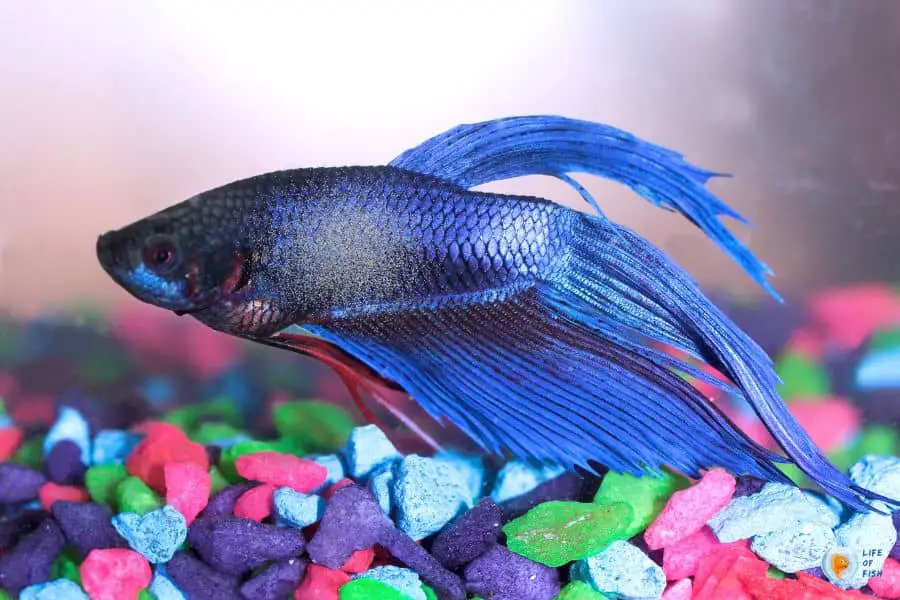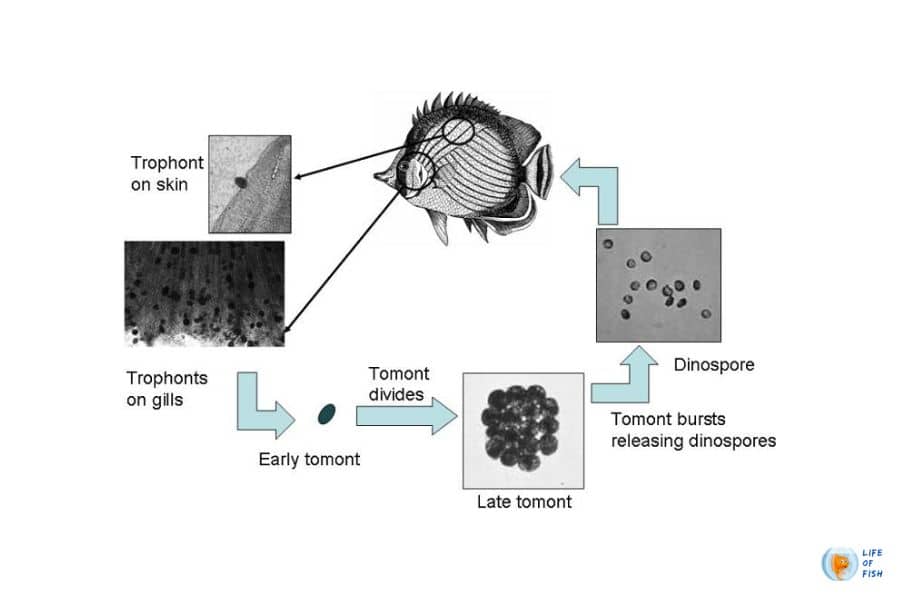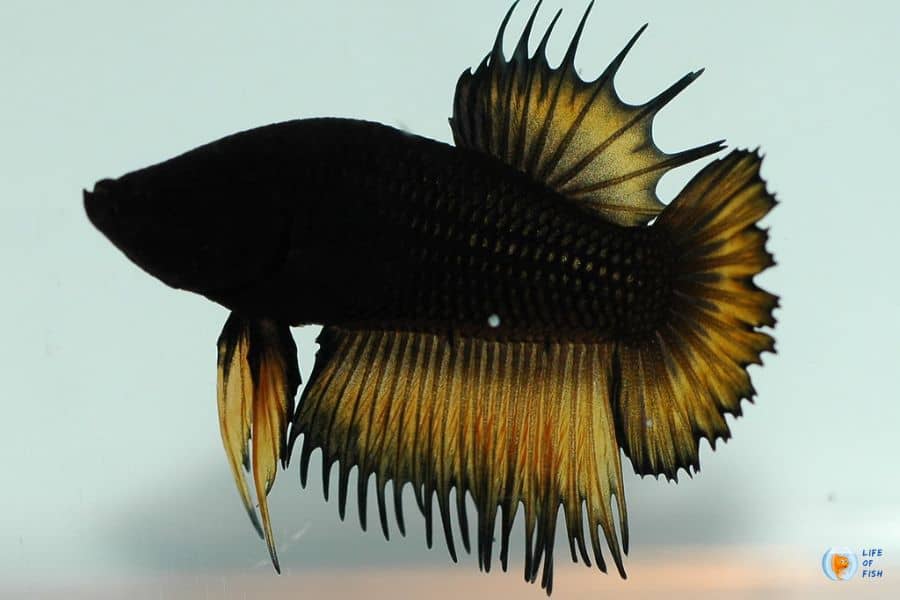As an experienced aquarist, I’ve seen firsthand the devastating effects of Velvet Disease on Betta fish. It’s a frustrating and often difficult illness to treat, but with the right knowledge and tools, it is possible to overcome.

In this comprehensive article, I’ll share everything you need to know about Velvet Disease in Betta fish, from its causes and symptoms to the best treatments and prevention methods. Whether you’re a seasoned fish keeper or a beginner, this article will provide you with the information you need to keep your Betta fish healthy and happy.
“Discover the top Betta Fish Diseases and how to keep your fish healthy! Click here to read our complete guide.” Betta Fish Diseases
What Is Velvet Disease?
Jump To
- 1 What Is Velvet Disease?
- 2 Velvet Disease Causes
- 3 Symptoms of velvat disease
- 4 Velvet Disease Treatment
- 5 Medicines to Use
- 6 How Long Does It Take To Treat Velvet In Betta Fish?
- 7 Velvet Disease Prevention
- 8 I’ve Cured Velvet But It Keeps Coming Back
- 9 Can Velvet Disease Come From Bacteria or a Virus?
- 10 Conclusion
Velvet Disease is a parasitic infection that affects freshwater fish, including Betta fish. The name comes from the velvety appearance of the infected fish, which results from the parasite’s tiny, velvety cysts on the fish’s skin. The disease is highly contagious and can spread rapidly through an aquarium, leading to devastating consequences if left untreated.
What Parasite Causes Betta Velvet?
Betta Velvet is caused by a parasitic protozoan called Piscinoodinium pillulare. This parasite belongs to the dinoflagellate family, and it infects the gills, skin, and fins of freshwater fish, including Betta fish.
The parasite has a complex life cycle that involves several stages, including the Tomont, Juvenile, and Adolescent stages. During the Juvenile stage, the parasite attaches itself to the fish’s skin, causing significant damage to the fish’s tissues and weakening its immune system.
Tomont
The first stage of the Velvet Disease parasite is the Tomont stage. At this stage, the parasite is still enclosed in a cyst. That cyst protects it from external factors such as changes in temperature, pH, and water quality.
The cyst is also resistant to most disinfectants, making it challenging to eradicate the parasite from an aquarium once it has established itself. During this stage, the parasite reproduces asexually by dividing itself into two or more cells, creating multiple cysts that can hatch and infect new hosts.
Juvenile
Once the cysts hatch, the parasite enters the Juvenile stage, which is the second stage of its life cycle. At this stage, the parasite becomes a free-swimming organism and seeks out a host.
The parasite attaches itself to the host’s skin and feeds on its mucus, blood, and skin cells, causing significant damage to the fish’s tissues. The Juvenile stage is particularly dangerous because the parasite can reproduce sexually at this stage, which increases the rate of infection and makes it difficult to control.
Adolescent
The Adolescent stage is the final stage of the Velvet Disease parasite’s life cycle. At this stage, the parasite matures and reproduces sexually, creating more cysts that can infect new hosts. The Adolescent stage is also the most visible stage.
In this stage, parasite is no longer microscopic and you can see them with the naked eye. Infected fish will often display visible symptoms such as a velvety appearance on their skin, lethargy, loss of appetite, and difficulty breathing. If left untreated, the disease can lead to death in a matter of days.

Velvet Disease Causes
Velvet Disease is a serious and potentially fatal ailment that can affect Betta fish. It is important to understand the various causes of Velvet Disease to effectively prevent and treat it in your aquarium.
Parasites
The most common cause of Velvet Disease is a parasitic protozoan called Piscinoodinium pillulare. This parasite is highly contagious and can quickly spread throughout an aquarium, infecting multiple fish.
Once a fish is infected, the parasite attaches itself to the fish’s skin, causing tiny velvety cysts. If left untreated, the cysts can cause significant damage to the fish’s tissues and eventually lead to death.
Poor Water Quality
Poor water quality is another major cause of Velvet Disease in Betta fish. When the water in the aquarium is dirty, contaminated, or poorly oxygenated, it can create an environment that is conducive to the growth of parasites and other harmful organisms. The stress of living in poor water conditions can also weaken a fish’s immune system, making it more susceptible to infections.
Stress
Stress is a significant contributing factor to the development of Velvet Disease in Betta fish. Stressful conditions such as overcrowding, poor water quality, and sudden changes in temperature or pH can cause a fish’s immune system to weaken, making it more vulnerable to infections. Fish that are stressed are also more likely to display symptoms of Velvet Disease, such as lethargy and loss of appetite.
Poor Nutrition
A poor diet can also contribute to the development of Velvet Disease in Betta fish. Fish that are not getting the proper nutrients they need to maintain a healthy immune system are more susceptible to infections. It is important to provide your Betta fish with a balanced diet that includes high-quality protein and vitamins to ensure they remain healthy and disease-free.
Symptoms of velvat disease
Incessant Scratching
One of the most common symptoms of Velvet Disease in Betta fish is incessant scratching. Affected fish will rub against objects in the aquarium in an attempt to alleviate the irritation caused by the parasite. If you notice your Betta fish scratching frequently or rubbing against objects in the aquarium, it may be a sign of Velvet Disease.
Cloudy Eyes
Another symptom of Velvet Disease in Betta fish is cloudy eyes. The parasite can cause inflammation of the eye, resulting in a cloudy or hazy appearance. If you notice your Betta fish’s eyes are cloudy or appear hazy, it is important to seek treatment immediately.
Peeling or Velvet-Like Growths
The parasite that causes Velvet Disease in Betta fish can also cause peeling or velvet-like growths on the skin. These growths may be white, gray, or yellow in color and may be visible on the fins, body, or head of the fish. If you notice any unusual growths on your Betta fish, it may be a sign of Velvet Disease.
Redness or Inflammation of the Skin
Redness or inflammation of the skin is another common symptom of Velvet Disease in Betta fish. The parasite can cause irritation and inflammation of the skin, resulting in redness or discoloration. If you notice your Betta fish’s skin appears red or inflamed, it may be a sign of Velvet Disease.
Clamped Fins
Affected Betta fish may also display clamped fins, a symptom commonly associated with stress. This can occur due to the irritation and discomfort caused by the parasite. If you notice your Betta fish’s fins are clamped or appear to be held tightly against their body, it may be a sign of Velvet Disease.
Fast Breathing or Gasping
Fast breathing or gasping is another symptom of Velvet Disease in Betta fish. The parasite can cause respiratory distress, making it difficult for the fish to breathe. If you notice your Betta fish is breathing rapidly or appears to be gasping for air, it may be a sign of Velvet Disease.
Loss of Appetite
Loss of appetite is another symptom commonly associated with Velvet Disease in Betta fish. The parasite can cause significant discomfort and may make it difficult for the fish to eat. If you notice your Betta fish is not eating or appears to have a decreased appetite, it may be a sign of Velvet Disease.
Fading or Darkening Colors
Finally, affected Betta fish may display a change in color. This can be due to the stress and discomfort caused by the parasite or a result of the infection itself. If you notice your Betta fish’s colors are fading or darkening, it may be a sign of Velvet Disease.

Velvet Disease Treatment
Betta velvet disease, also known as velvet disease or gold dust disease, is a parasitic infection caused by Piscinoodinium pillulare. This microscopic parasite can affect both freshwater and saltwater fish, including Betta fish. If left untreated, velvet disease can quickly become fatal for your Betta.
Fortunately, with prompt treatment, velvet disease can be cured. In this article, we’ll discuss the steps you can take to treat velvet disease in Betta fish.
Isolate Your Betta
The first step in treating velvet disease is to isolate your Betta from any other fish in the tank. Velvet disease is highly contagious and can quickly spread to other fish in the tank. It’s important to move your Betta to a quarantine tank to prevent the spread of the disease.
Turn up the Temperature
The next step is to increase the temperature in the quarantine tank. Velvet disease thrives in cooler temperatures, so raising the temperature to around 86°F (30°C) can help to kill off the parasite. However, make sure not to raise the temperature too quickly, as this can cause stress for your Betta.
Keep the Tank in the Dark
Velvet disease is photosensitive, which means that light can stimulate the growth of the parasite. Keeping the quarantine tank in the dark can help to slow down the growth of the parasite and give your Betta a better chance of recovery.
Check the Water Parameters
It’s important to check the water parameters in the quarantine tank regularly. Velvet disease can weaken your Betta’s immune system, making them more susceptible to other illnesses. Make sure to keep the water clean and free of toxins by doing frequent water changes.
Use a Velvet Disease Treatment
There are a number of velvet disease treatments available on the market. Look for a treatment that contains copper or malachite green, as these are effective in killing the parasite. However, make sure to follow the instructions carefully and avoid over-dosing, as this can be harmful to your Betta.
Water Changes
After treatment, it’s important to do frequent water changes to remove any remaining toxins from the quarantine tank. It’s recommended to do daily water changes for several days after treatment to ensure that the water quality is optimal for your Betta.
Medicines to Use
When it comes to treating Betta Velvet Disease, there are several medicines that can be used to eradicate the parasite responsible for the infection. These medications are typically added to the aquarium water, and work by killing off the parasite at different stages of its life cycle.
One commonly used medication for treating Velvet Disease is Malachite Green. This medication is effective against the juvenile and adolescent stages of the parasite, making it an ideal choice for combating this disease. Malachite Green is also effective against other types of parasites, such as ich and flukes, making it a versatile choice for fish owners.
Another medication that can be used to treat Betta Velvet Disease is Copper Sulphate. Copper Sulphate is particularly effective against the tomont stage of the parasite, making it an important medication for eliminating the disease from your aquarium. However, it’s important to note that Copper Sulphate can be toxic to fish in high concentrations, so it should be used with caution.
Sodium Chloride, or salt, is also effective in treating Betta Velvet Disease. When added to the aquarium, salt can help to kill off the parasite by dehydrating it. This medication is particularly useful for controlling the spread of Velvet Disease in a community tank, as it is safe for most fish species and can help to prevent the spread of other types of diseases.
It’s important to note that when using medications to treat Betta Velvet Disease, it’s important to follow the instructions carefully and to monitor your fish closely for any signs of stress or adverse reactions. Additionally, it’s important to make sure that the water parameters in your aquarium are optimal, as this can help to improve the effectiveness of the medication and prevent further infections from occurring.
How Long Does It Take To Treat Velvet In Betta Fish?
Treating Velvet Disease in Betta fish can take anywhere from a few days to several weeks, depending on the severity of the infection and the overall health of the fish. It’s important to continue treatment until all signs of the disease have disappeared to ensure that the parasite responsible for Velvet Disease has been completely eliminated. Regular water changes and proper maintenance of the aquarium can also help to speed up the recovery process.
Velvet Disease Prevention
Preventing Velvet Disease from occurring in Betta fish requires good aquarium maintenance and care. This includes regular water changes, monitoring the water parameters, and keeping the tank clean and well-maintained.
Quarantining new fish before introducing them to the main aquarium can also help to prevent the spread of diseases. Additionally, there are products available on the market, such as medications and supplements, that can help to boost the immune system of your fish and prevent Velvet Disease.
I’ve Cured Velvet But It Keeps Coming Back
If you have successfully treated Velvet Disease in your Betta fish, but the infection keeps coming back, there may be underlying issues with the aquarium environment or the fish themselves. Poor water quality, overcrowding, and a weakened immune system can all make fish more susceptible to disease.
It’s important to address these issues to prevent Velvet Disease from recurring and keep your fish healthy and happy. Continuing treatment until all signs of the disease have disappeared can also help to eliminate the parasite responsible for Velvet Disease.
Can Velvet Disease Come From Bacteria or a Virus?
No, Velvet Disease is caused by a parasitic protozoan and cannot come from bacteria or a virus. The disease is highly contagious and can spread rapidly throughout an aquarium if left untreated. Therefore, it is essential to quarantine any new fish before introducing them to the main aquarium and to maintain proper water quality and filtration to prevent the spread of the disease.
Conclusion
In conclusion, Velvet Disease can be a serious threat to the health and well-being of your Betta fish. But with early detection and proper treatment, you can help your fish recover and prevent the disease from returning. By following the expert advice and preventative measures outlined in this comprehensive guide, you can keep your Betta fish healthy and happy for years to come.
Remember to always monitor your fish’s behavior and appearance, and don’t hesitate to seek professional help if necessary. With a little care and attention, you can provide your Betta fish with a safe and healthy environment they can thrive in.
Read Next: Betta Fish Fungus: A Complete Guide to Diagnosis and Treatment
Read Next: Betta Fish Ich: Causes, Symptoms, and Treatment
